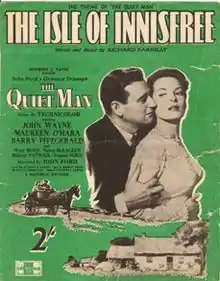Isle of Innisfree
The "Isle of Innisfree" is a song composed by Dick Farrelly (Irish songwriter, policeman and poet, born Richard Farrelly), who wrote both the music and lyrics. Farrelly got the inspiration for "Isle of Innisfree", the song for which he is best remembered, while on a bus journey from his native Kells, County Meath to Dublin. The song was published in 1950 by the Peter Maurice Music Publishing Co.

Farrelly’s "Isle of Innisfree" is a haunting melody with lyrics expressing the longing of an Irish emigrant for his native land. When film director John Ford heard the song, he loved it so much that he chose it as the principal theme of his film The Quiet Man.[1] The composition received no mention in the screen credits. "The Isle of Innisfree" became a worldwide hit for Bing Crosby in 1952 and continues to feature in the repertoires of many artists.
There is a common misconception that the song and the famous poem by W. B. Yeats, "Lake Isle of Innisfree", were written about the same place. Yeats' Innisfree was an uninhabited island in Sligo's Lough Gill, whereas Farrelly's Innisfree represented all of Ireland.[2][3]
The song remains popular and has been recorded by hundreds of artists around the world.
Films
"Isle of Innisfree" is the principal musical theme of the film The Quiet Man (1952). It features in Steven Spielberg's film E.T. the Extra-Terrestrial (1982) when the famous kissing scene between John Wayne and Maureen O'Hara in The Quiet Man is shown. The melody is also included in the soundtracks of the films Distant Voices, Still Lives (1988) and Breakfast on Pluto (2005).
Analysis
The song was also featured in the RTÉ Radio arts programme Rattlebag as one of the top 75 Irish songs of all time in a series entitled "The Story Behind The Songs". Des MacHale (writer and mathematician) and Dick Farrelly's son Gerard were contributors on the programme. There is also a BBC Northern Ireland television series, "Brian Kennedy on Song", in which "Isle of Innisfree" is featured and discussed.
In a chapter entitled "Richard Farrelly and The Isle of Innisfree" of his book Picture The Quiet Man, Professor Des MacHale wrote:
"It is one of the finest and most beautiful melodies ever written, ranking in the opinion of many, right beside Danny Boy and no greater praise is possible. But its appeal is also timeless and international, expressing as it does the trauma of separation from one's birthplace and the ecstasy of returning to the physical soil from which one is sprung... But it is the sheer unanswerable beauty of the melody of Richard Farrelly's The Isle of Innisfree that makes the greatest impact and dwells so deeply in the memory. Here is music dripping with emotion, lush texture, brimming with nostalgia, and fitting so perfectly into the action of The Quiet Man that it could have been written with the movie in mind. No wonder John Ford jumped on it and named the village of Innisfree in its honour".[1]
Performance history
The first public performance of the song was at a social event in the St. Vincent De Paul Hall in Kells, Co. Meath on St. Patrick's Night 1950. The "Isle of Innisfree" and "Seolta Bána" by Dick Farrelly were performed by Sinead Stone and Gerard Farrelly (Dick Farrelly's son) for Irish actress Maureen O'Hara at her induction into the Irish America Hall of Fame at the JFK Heritage Centre in New Ross, County Wexford, in July 2011. In May 2012 they performed the "Isle of Innisfree" and other Dick Farrelly songs for President Michael D. Higgins at the George Bernard Shaw International Conference which took place in the National Gallery of Ireland.
References
- Professor Des MacHale (2004). Picture The Quiet Man. Appletree Press.
- Extract from Peter Murphy's interview with Dick Farrelly in July 1990 on RTÉ (Ireland's National Broadcasting Station): "The "Isle of Innisfree" that was in my mind was Ireland, another name for Ireland, and that's something people often get mixed up".
- The Sunday Independent, 28 December 1952: "For me, 'The Isle of Innisfree' is simply Ireland, and it was Ireland I had in mind when I wrote this song about an exile's longing for home. The whole song, words and music, was composed in half an hour on that bus. I know that by the time I got to Dublin I had my song, the complete words and music... "Of course, it's not as easy as all that, and sometimes, for instance, I have waited for weeks to get the last line of a song".
External links
- Lyrics of The Isle of Innisfree
- Dick Farrelly's musical legacy
- Garda Review Magazine. Scroll down to article – An Garda Siochana & The Quiet Man Connection
- The Quiet Man: Soundtrack, track listing & audio samples
- Spotlight on Dick Farrelly & 'Legacy of a Quiet Man' album
- Musician Gerard Farrelly's site
- Picture The Quiet Man, book by Des MacHale
- The Story Behind The Songs, Rattlebag, RTE Radio Arts Programme
- Irish Music Rights Organisation – 'Legacy Of A Quiet Man CD' article
- Lyrics of The Isle of Innisfree